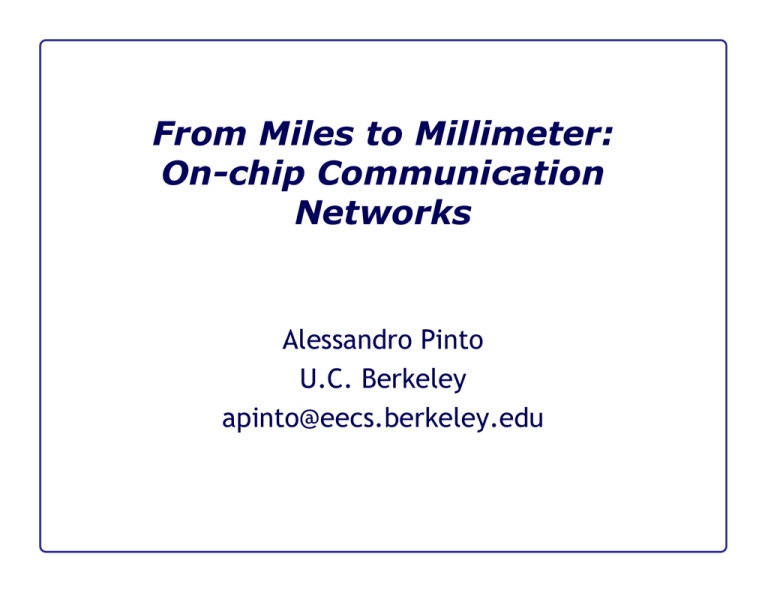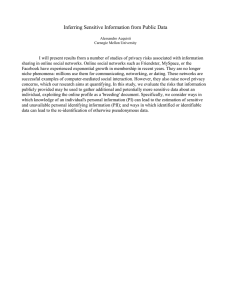From Miles to Millimeter: On-chip Communication Networks
advertisement

From Miles to Millimeter:
On-chip Communication
Networks
Alessandro Pinto
U.C. Berkeley
apinto@eecs.berkeley.edu
What
Communication synthesis
What is the “best way” of transferring
information between entities
Problem Formulation
Who wants to communicate with whom
How he aspects the communication mechanism
to behave
What is possible to built today
How to build a communication architecture that
is cheap and satisfies the entities constraints
while being feasible
Alessandro Pinto
Chips are small, why bother?
“As designs scale to newer technologies, they get smaller and their wires
get shorter, and the relative change in the speed of wires to the
speed of gates is modest.” M.A.Horowitz et.al “The future of wires”
“The real wire problem arises with increasing chip complexity and global
communication costs.” M.A.Horowitz et.al “The future of wires”
Scaling
Local Wire
Global Wire
Alessandro Pinto
Networks vs. On-Chip Networks
Internet major concern
was to guarantee
connectivity in case of
attack
Cost is mostly static
Buffers memory is not a
problem (512MB is still
cheap)
Number and complexity
of protocol layer is
important only for
performance issues
Alessandro Pinto
Full connectivity is not
the major concern
Now cost is mostly
dynamic (power)
Registers are expensive
The protocol must be
very light
In the future error
correction might become
a reality
Communication Platform Stack
T o p o lo g y Desig n
Ap p licatio n Sp ace
API
Netwo r k L ayer
Pr o to co l Desig n
Ph ysical L evel
Im p lem en tatio n Sp ace
Ro u tin g
Alessandro Pinto
M AC L ayer
The Problem
ArchPltBuilder
RTOS
µC1
µC2
DSP
HW
MEM
To Silicon
Alessandro Pinto
Basic Definitions: Comm. Graph
G(V,E,P,ω)
V=S U V’ U D
S,D not emtpy
P=Xi pi is a performance domain
ω: E(G) → P
If the graph is placed
Π: V(G) → Pos
Ce: E(G) → Cost, Cv: V(G) → Cost
CG = ∑e∈E(G) Ce + ∑v∈V(G) Cv
Alessandro Pinto
A More General Defintion
Two types of quantities
Series (e.g. position of nodes)
Parallel (e.g. bandwidth). Must sum up to 0
on a cut
P=PS X PP
Communication Graph
G(V,E,P,ω, Π)
ω: E(G) → PP
Π: V(G) → PS
Alessandro Pinto
Flows
Defined as usual in flow networks
f: V(G) x V(G) → PP
Flow between two nodes:
F(u,v) = max (f(u,v))
Alessandro Pinto
Graph Ordering
G1 ⊆ G2
S1 = S2, D1=D2, Π1|S1,D1= Π2|S2,D2
|V’1|≥|V’2|
For all si,dj, F1(si,dj) ≥ F2(si,dj)
G1 implements G2
Alessandro Pinto
Communication Constraints Graph
Obs.: if V’=∅ the F(u,v) = ω(e(u,v))
Specification
Def.: A Communication Constraint Graph
is a communication graph such that V’=∅
Alessandro Pinto
Implementation Graph
Given a communicaiton grpah G,
define J(G) = {G’ |G’ ⊆G }
Im plem entation
Def.: The Implementation Graph of a
communication graph G is the solution
to the optimization problem
min CG '
G '∈J ( G )
Alessandro Pinto
The Optimization Problem
Given a Communication Constraint Graph G,
find its Implementation Graph G’
Obs.:
Two vertices s.t. Π(n1) = Π(n2) can be considered
to be the same vertex
An edge s.t. ω(e) = 0 can be removed
E connected minimum tree with n leaves has at
most n-2 non leaves vertices
A connected tree can be obtained by contraction
or by removing edges
Alessandro Pinto
The Optimization Problem
min C (G ' )
D1
S1
ω ',Π '
ω(e)
sbj to G
S2
D2
f(S1,D2)
n2
n1
S1
D1
min C (G ' )
ω ',Π '
sbj to ∀e( si , d j ) ∈ G,
S2
A' f ' ≥ ω (e)d
n3
n4
AIN
Alessandro Pinto
D2
Put the protocol into the picture
As you noticed I use ≥ for the flows
Three possibilities:
The topology design relies on the protocol
The protocol performance/cost impact the topology
The protocol design relies on the topology
The topology performance/cost impact the protocol
A joint optimization is carried out (best result
but very difficult)
Alessandro Pinto
Splitting the nodes
Each AIN is split into two nodes:
Network Switching Node (NSN)
Network Interface Node (NIN)
Network
S
NIN
One pair for
each S/D
Alessandro Pinto
NSN
Trade Off Example
Characterize each source with ba,bm,bl,br
Average b., maximum b., maximum burst length,
maximum blocking rate
Simple back-pressure mechanism: activate a
signal to freeze the source (correspond to
slowing down the source)
S
NIN
Alessandro Pinto
NSN
Trade Off Example: case 1
Optimize the protocol considering
Queue length
Blocking time
min
br
∑ (k br
S
S
+N S (br ) )
S
sbj. to ∀ e( NIN i , NSN i ),
ω (e) = bai
Optimize the topology in the average case
This is an abstraction of the protocol performances
Alessandro Pinto
Trade Off Example: case 2
G’ is given (the topology is fixed)
For each (si,dj), F(si,dj) is known
All the things we have seen in class
Find the routing algorithm
Find the flow control algorithm
Alessandro Pinto
Just a Taste of the Library
1.4
Pitc h
1.2
1
0.8
Thic k ne s s
Energy(pJ)
0.6
Mn+1
0.4
D ie le c tric
Spa c e
Mn
0.2
0
M1
buffer
M3
M4
M5
M6
450
400
350
buffer
300
250
200
150
100
50
0
sopt
lcrit
M2
τ crit ≈ 17 ps
Sopt(*minsize)
M1 M2 M3 M4 M5 M6
P ∝ Es f
Alessandro Pinto
l
lcrit
Conclusions
The notion of communication graph has been
introduced
An optimization problem has been derived
for the synthesis of networks
The interaction between protocol and
topology optimization has been analyzed
Alessandro Pinto
Future Work
Get the software running
Find a good NLP package
Solve other mixed integer programming
problems
Path uniqueness
Interface with other tools
Protocol synthesis
Edge covering
Interface Synthesis
Use it
Alessandro Pinto
